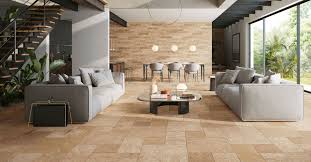Travertine stone stands as one of nature’s most elegant gifts to architecture and design. This sedimentary rock, formed over thousands of years through mineral deposits from hot springs and limestone caves, brings an organic sophistication that synthetic materials simply cannot replicate. When you choose travertine for your design projects, you’re selecting a material that tells a story of geological artistry.
The visual appeal of Travertine stone lies in its distinctive texture and color variations. Each piece showcases unique patterns created by natural processes, featuring subtle holes and grooves that give surfaces character and depth. These natural imperfections become design assets, creating visual interest that changes throughout the day as light shifts across the stone’s surface. The warm earth tones range from creamy whites and soft beiges to rich golds and rustic browns, offering designers a palette that complements both contemporary and traditional aesthetics.
Architectural Applications That Showcase Natural Elegance
Travertine excels in multiple architectural applications where its natural beauty can shine. For exterior facades, the stone provides weather resistance while maintaining visual appeal across seasons. The material’s natural insulation properties help regulate temperature, making buildings more energy efficient while reducing environmental impact.
Interior applications reveal travertine’s versatility. Flooring installations benefit from the stone’s durability and natural slip resistance, particularly when finished with appropriate surface treatments. The material handles high-traffic areas exceptionally well, developing a beautiful patina over time rather than showing wear patterns like many manufactured alternatives.
Wall applications transform ordinary spaces into sophisticated environments. Whether used as accent walls or full room treatments, travertine creates texture and visual warmth that enhances both residential and commercial interiors. The stone’s ability to work with various lighting conditions makes it particularly valuable in spaces where ambiance matters.
Working with Natural Variations
Understanding travertine’s natural characteristics helps designers maximize its potential. Color consistency varies between quarries and even within individual blocks, requiring careful selection and planning during installation. This variation becomes an asset when properly managed, creating organic flow throughout spaces rather than the sterile uniformity of manufactured materials.
Surface finishing options expand travertine’s design possibilities. Tumbled finishes create rustic, aged appearances perfect for traditional or Mediterranean-inspired designs. Honed surfaces offer smooth, matte finishes that work well in contemporary settings while maintaining the stone’s natural character. Filled travertine provides smoother surfaces for high-traffic areas while preserving the material’s distinctive appearance.
Sustainable Design Benefits
Travertine supports sustainable design practices through its natural properties and longevity. The material requires minimal processing compared to synthetic alternatives, reducing environmental impact during production. Its thermal mass properties contribute to energy efficiency in buildings, helping maintain comfortable temperatures while reducing heating and cooling costs.
The stone’s durability means installations last for decades with proper maintenance, reducing replacement needs and associated environmental costs. Many historical travertine installations continue performing beautifully after centuries, demonstrating the material’s long-term value proposition.
Installation Considerations for Optimal Results
Successful travertine installations require understanding the material’s specific needs. Proper substrate preparation ensures long-term performance, while appropriate sealing protects against staining and moisture infiltration. Professional installation becomes particularly important for large-format pieces where precise alignment and support matter most.
Climate considerations affect travertine selection and installation methods. Areas with freeze-thaw cycles require specific varieties and installation techniques to prevent damage. Interior applications offer more flexibility while still requiring attention to expansion joints and proper ventilation.
Creating Cohesive Design Statements
Travertine works exceptionally well as part of broader natural material palettes. Combining it with wood, natural fibers, and other stone varieties creates cohesive environments that feel connected to nature. The key lies in understanding how different textures and colors interact within specific lighting conditions.
Color coordination extends beyond the stone itself to encompass surrounding materials and finishes. Travertine’s warm undertones complement both cool and warm color schemes when properly balanced with other design elements.
Incorporating travertine stone into your design projects means embracing nature’s artistry while creating spaces that feel both timeless and contemporary. This remarkable material offers designers the opportunity to work with geological history, creating environments that connect occupants with natural beauty while providing the durability and performance modern projects demand.









